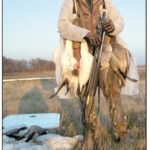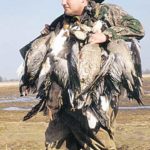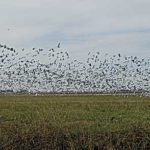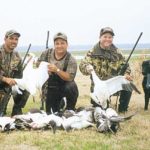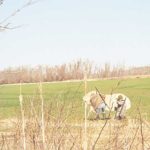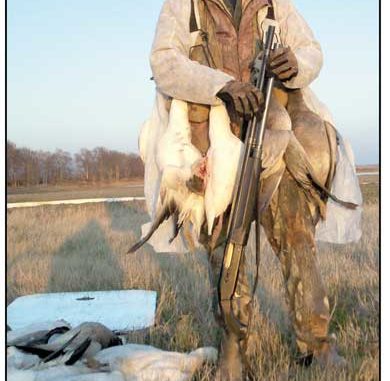
Use this new device, and you’ll be able to walk right up to a flock of feeding geese.
Lying with our backs against the side of an Arkansas ditch huffing and puffing trying to catch our breath is where I remember my buddy’s words that offered no relief to the pains that would later become that night’s leg and body cramps.
“If we had been doing this back when we were in high-school-football shape, the goose population wouldn’t be in the condition it’s in today,” he whispered as if the raucous geese we were trying to sneak up on could actually hear us.
Steve Tenhundfeld and I go back a long way — all the way back through 40 years of high-school reunions, back to football seasons when you weren’t a defensive, offensive or special-teams player — you played both ways — back to the weekend dances where we dreamed about overly developed teen-aged girls, all the way back to the kind of mischief and misadventures that devious fifth-graders can get into.
And along the way during those early years, we had plenty of ill-prepped fishing and hunting trips that always seemed to go awry.
And now decades later, a little déjà vu was setting in. You see, since the practice of goose creeping has become an accepted, even encouraged, conservation method to help control snow, blue and Ross’ goose populations, Steve has volunteered into service under the banner of the federal Conservation Order.
Steve, who grew up in South Louisiana and returns often, has hunted and fished in the several states in which he’s lived. Currently he lives in Germantown, just outside Memphis, where he hunts deer, turkeys, ducks and doves.
From there, it’s a short drive to across the Arkansas state line, where the expansive wheat and rice fields provide a target-rich environment for what has become Steve’s obsession — goose hunting. No, make that goose creeping, crawling, stalking or whatever you want to call it.
And he goes at it with more reckless abandon than a lot of much-younger hunters would. He regularly recruits new hunters (for reasons discussed later, the life expectancy of a goose creeper isn’t exactly the greatest).
So naturally, given our sordid pasts, he knew I would be a likely candidate, and invited me up for the first time almost a decade ago.
I had mixed feelings about goose-creeping. First, decoying light geese, except in a few unique situations, is an exercise in futility. Secondly, the notion of sneaking up on feeding or resting geese to get in position to legally open fire with an unplugged gun with the intention of annihilating as many as possible for good cause does have both exhilarating and shameful sides.
Being from Louisiana adds an extra stigma to creeping. For several years, we were the only state that made this particular hunting technique illegal. However, those were the days before overpopulation, and I don’t believe a single case was ever prosecuted. I always believed it was more an issue of trespass than ethics, and the baseless law has been all but forgotten.
While it sounds pretty simple, goose creep hunting actually is quite an art. Credit the goose’s ability to adapt for its success in exploding its population. It’s that quality that makes it so difficult for hunters to make an appreciable dent in their numbers, even considering the relaxed regulations aimed at giving hunters the advantage.
That’s why Steve, and hunters like him, are constantly looking for new twists and tactics to stay one step ahead of the geese.
How effective is goose creeping? The best one-day hunt I’ve ever made was 102 shot by our group of five hunters.
Steve’s personal best is 141, but he says over the years he’s averaged 75-100 depending on how many geese he finds in smaller areas, allowing him to make multiple creeps on bigger flocks.
I have participated in the conservation order since its inception, and have found the only way to effectively hunt the geese is by doing what most hunters are not willing to do. I’m talking about creeping or sneaking, stalking, crawling or whatever term you use to describe approaching feeding geese by staying concealed in ditches or cover. It’s not easy, and usually more unsuccessful than not.
After years of trial and error, Steve and I have learned a lot about how geese use their numbers and senses to survive, and they’re damned good at it. Normally, when humans approach a huge body of geese, unless completely hidden, the sentries belt out a warning and head skyward. In a matter of seconds, the field is empty long before hunters get into shotgun range.
Over the years we’ve tried alternate methods of stalking geese, but usually success is directly tied to the lay of the land. Rarely will geese get close enough to a deep ditch or a wooded tree line to allow hunters to approach slowly and well-hidden. Years of experience has taught them to stay in the center of vast, wide-open fields.
We’ve experimented with other methods. One that worked with some success was to hide behind a makeshift cardboard cutout of a cow and approach the flock slowly as would a grazing herd. Geese sometimes will ignore cattle, as they have learned they pose no threat. But more often, while the flock may not vacate the field, they will simply walk away well ahead of gun range.
Last year, instead of the usual nasty job of crawling and creeping in mud, we were testing a new tool called the Shadow Shield. It’s a simple concept, one I often thought about but couldn’t convince anyone to produce.
It’s a rectangular shield with handles, a small peephole to see through and a reflective mirror finish on the outside. With this, the hunter can hide behind the shield as he approaches, and the game only sees a reflection of themselves and whatever habitat they’re in.
So when we tried it for the first time, I was amazed at how close to the flock we got. I’m not sure how close we could have gotten, but we stopped when we were in good shooting range, dropped the shields and that’s when I was as surprised as the geese were. They were totally fooled, and appeared to be in momentary shock. One second they were seeing geese in our direction, and the next they saw two hunters pointing barrels in their direction.
We bagged 25 geese from a flock of about 4,000, a small dent, but without the shields they were unapproachable.
After hunting an entire day, we learned that the Shadow Shield does not work every time on huge snow-goose flocks. Sometimes there’s so many that the ones on the sides will bust you, or if there’s too much variety in the scenery or if you let your gun barrel extend over the top or make too much side movement with the shield, it will spook them.
But it sure beats low-crawling in a wet ditch and wishing for days of youthful energy long gone by.
